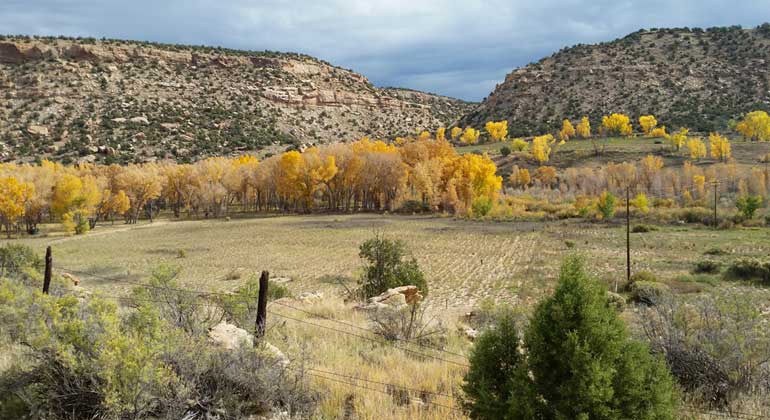Shunned by microbes, organic carbon can resist breakdown in underground environments, Stanford scientists say
A new study reveals that organic matter whose breakdown would yield only minimal energy for hungry microorganisms preferentially builds up in floodplains, illuminating a new mechanism of carbon sequestration.
The soils and sediments beneath our feet can contain an astonishing amount of carbon – more than in all of the world’s plants and the atmosphere combined – and represents a significant potential source of the greenhouse gas carbon dioxide.
In a new study, Stanford scientists have uncovered a previously unknown mechanism that explains why microbes sometimes fail to break down all the plant and animal matter, leaving carbon underfoot. Understanding where, and how long, this buried organic matter lingers is crucial for scientists and policymakers to better predict and respond to climate change.
“Our picture of how organic matter is broken down in soils and sediments is incomplete,” said study lead author Kristin Boye, an associate staff scientist at the Stanford Synchrotron Radiation Lightsource at the SLAC National Accelerator Laboratory and former postdoctoral scholar at Stanford’s School of Earth, Energy & Environmental Sciences. “With this study, we are gaining new insights into the mechanisms of carbon preservation in low- or no-oxygen subterranean environments.”
In oxygen-starved places such as marshes and in floodplains, microorganisms do not equally break down all of the available organic matter, the study shows. Instead, carbon compounds that do not provide enough energy to be worthwhile for microorganisms to degrade end up accumulating. This passed-over carbon, however, does not necessarily stay locked away below ground in the long run. Being water soluble, the carbon can seep into nearby oxygen-rich waterways, where microbes readily consume it.
To date, models of local ecosystems and broader climate change have failed to take into account this newfound carbon preservation mechanism, having focused chiefly on microbial enzymes and the availability of other elements for organic matter breakdown.
“Soils and sediments are a huge and dynamic reservoir of carbon,” said study senior author Scott Fendorf, a professor of soil biogeochemistry at Stanford Earth. “That’s why we worry about turnover times here with regard to how fast organic carbon is degraded and released as carbon dioxide into the atmosphere.”
Tracking the fate of the carbon
For the new study, published in Nature Geoscience, the research team collected core samples of buried sediments from four floodplains in the upper Colorado River Basin in the states of Colorado and New Mexico.
The approximately 3-foot-long, column-shaped samples went deep enough to reach oxygen-starved layers where microbes must switch from doing the microbial equivalent of breathing oxygen to breathing sulfur. In either case, the microbes combine oxygen or sulfur with carbon-based food to produce energy and release either carbon dioxide or sulfur dioxide into the atmosphere. (That sulfur dioxide is responsible for the distinctive smell of oxygen-poor wetlands.)
To identify where in the sediment samples microbes had made the switch, the researchers turned to the Stanford Synchrotron Radiation Lightsource facility. The synchrotron machine generates extremely bright X-ray light that, when shone upon the samples, generates a signal revealing the chemistry of the sulfur. The presence of sulfide minerals indicates where the microbes began making use of sulfur alongside carbon to power their biochemical machinery.
The question was whether the switch to sulfur influenced the carbon sources the microbes ate or left behind. To find out, the researchers relied on unique instrumentation and collaborations within the Environmental Molecular Sciences Laboratory at the Pacific Northwest National Laboratory in Richland, Washington. With the aid of a very strong magnet, an instrument called a mass spectrometer at the lab characterized the water-soluble organic material. The tests found that, in contrast to the layers where oxygen was available, leftover carbon compounds in the sediment samples where sulfur had been used for respiration were mostly of the sort that requires more energy to degrade than would be liberated through the degradation itself. Of no use, then, to growing microbes, these carbon compounds had remained within the deeper sediment layers.
Honing models of the carbon cycle
Floodplains, like those sampled in the study, rank among the most common areas globally for the internment of plant and animal matter by water-borne sediments. The oxygen-poor conditions created underground there are known to sequester carbon, but as the study suggests, partly for reasons previously unrecognized and with unforeseen consequences. For such flood-prone, low-lying areas are by definition close to waterways. Soluble, unused organic material can migrate quite easily into an aerated waterway for subsequent breakdown, triggering algae blooms and other water quality issues while also leading to carbon dioxide production.
Models of how living organisms, the ground, bodies of water and the atmosphere recycle carbon will increasingly need to incorporate key nuances, like the preservation mechanism described in the new Stanford study, in order to inform scientists’ understanding as well as policymakers’ decisions.
“Getting the constraints right on what really controls the processes of carbon breakdown is essential,” said Fendorf. “That’s what our study helps illuminate.”
Other co-authors on the study, titled “Thermodynamically controlled preservation of organic carbon in floodplains,” include Vincent Noel, Sharon Bone and John Bargar of the SLAC National Accelerator Laboratory; Malak Tfaily of the Pacific Northwest National Laboratory; and Kenneth Williams of the Lawrence Berkeley National Laboratory. Funding was provided by the U.S. Department of Energy, the Office of Biological and Environmental Research, the SLAC National Accelerator Laboratory and the Lawrence Berkeley National Laboratory.








